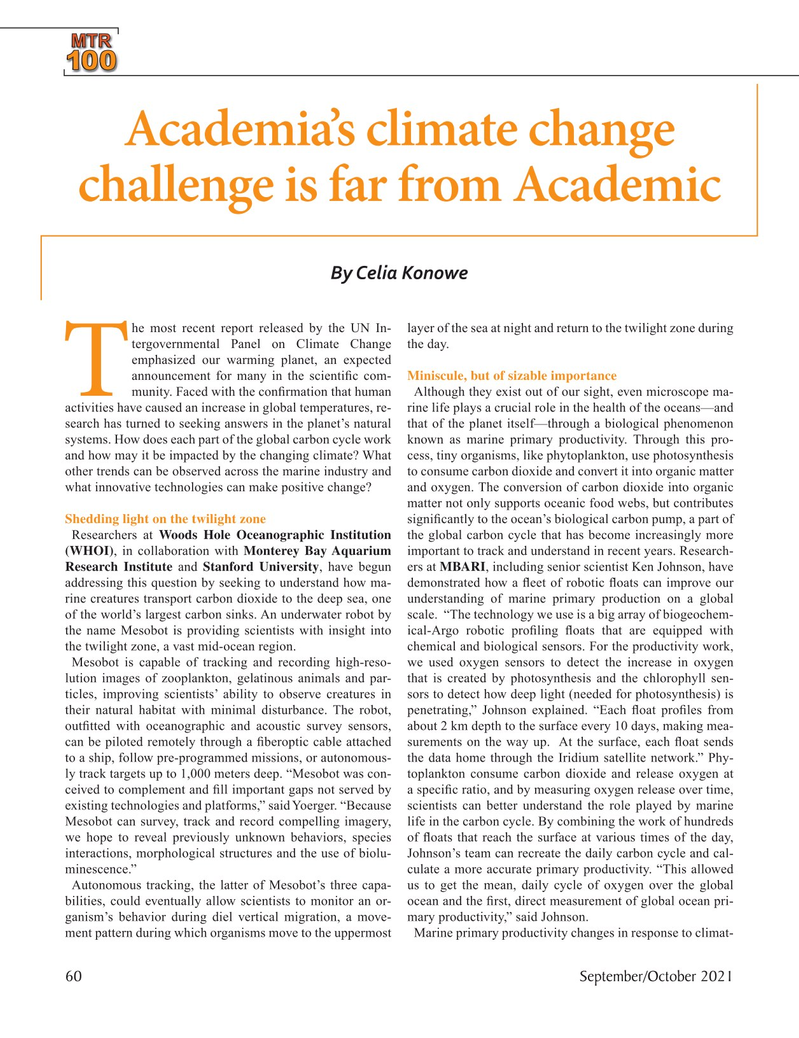
Page 60: of Marine Technology Magazine (September 2021)
MTR100: Focus on 100 Leading Companies, People and Innovations in the Subsea Space
Read this page in Pdf, Flash or Html5 edition of September 2021 Marine Technology Magazine
MTTTTTTTTTTTTTRM M M M M M M M M M M M M M M M M M M M M M M M M M M M MTRRRRRRRRRRRRRRRRRRRRRRRRRRRMTTTTTTTTTTTTTRMTR 100000000000000001111111111111111111111111111100000000000000000000000000000010000000000000000100
Academia’s climate change challenge is far from Academic
By Celia Konowe he most recent report released by the UN In- layer of the sea at night and return to the twilight zone during tergovernmental Panel on Climate Change the day.
emphasized our warming planet, an expected announcement for many in the scienti? c com- Miniscule, but of sizable importance
T munity. Faced with the con? rmation that human Although they exist out of our sight, even microscope ma- activities have caused an increase in global temperatures, re- rine life plays a crucial role in the health of the oceans—and search has turned to seeking answers in the planet’s natural that of the planet itself—through a biological phenomenon systems. How does each part of the global carbon cycle work known as marine primary productivity. Through this pro- and how may it be impacted by the changing climate? What cess, tiny organisms, like phytoplankton, use photosynthesis other trends can be observed across the marine industry and to consume carbon dioxide and convert it into organic matter what innovative technologies can make positive change? and oxygen. The conversion of carbon dioxide into organic matter not only supports oceanic food webs, but contributes
Shedding light on the twilight zone signi? cantly to the ocean’s biological carbon pump, a part of
Researchers at Woods Hole Oceanographic Institution the global carbon cycle that has become increasingly more (WHOI), in collaboration with Monterey Bay Aquarium important to track and understand in recent years. Research-
Research Institute and Stanford University, have begun ers at MBARI, including senior scientist Ken Johnson, have addressing this question by seeking to understand how ma- demonstrated how a ? eet of robotic ? oats can improve our rine creatures transport carbon dioxide to the deep sea, one understanding of marine primary production on a global of the world’s largest carbon sinks. An underwater robot by scale. “The technology we use is a big array of biogeochem- the name Mesobot is providing scientists with insight into ical-Argo robotic pro? ling ? oats that are equipped with the twilight zone, a vast mid-ocean region. chemical and biological sensors. For the productivity work,
Mesobot is capable of tracking and recording high-reso- we used oxygen sensors to detect the increase in oxygen lution images of zooplankton, gelatinous animals and par- that is created by photosynthesis and the chlorophyll sen- ticles, improving scientists’ ability to observe creatures in sors to detect how deep light (needed for photosynthesis) is their natural habitat with minimal disturbance. The robot, penetrating,” Johnson explained. “Each ? oat pro? les from out? tted with oceanographic and acoustic survey sensors, about 2 km depth to the surface every 10 days, making mea- can be piloted remotely through a ? beroptic cable attached surements on the way up. At the surface, each ? oat sends to a ship, follow pre-programmed missions, or autonomous- the data home through the Iridium satellite network.” Phy- ly track targets up to 1,000 meters deep. “Mesobot was con- toplankton consume carbon dioxide and release oxygen at ceived to complement and ? ll important gaps not served by a speci? c ratio, and by measuring oxygen release over time, existing technologies and platforms,” said Yoerger. “Because scientists can better understand the role played by marine
Mesobot can survey, track and record compelling imagery, life in the carbon cycle. By combining the work of hundreds we hope to reveal previously unknown behaviors, species of ? oats that reach the surface at various times of the day, interactions, morphological structures and the use of biolu- Johnson’s team can recreate the daily carbon cycle and cal- minescence.” culate a more accurate primary productivity. “This allowed
Autonomous tracking, the latter of Mesobot’s three capa- us to get the mean, daily cycle of oxygen over the global bilities, could eventually allow scientists to monitor an or- ocean and the ? rst, direct measurement of global ocean pri- ganism’s behavior during diel vertical migration, a move- mary productivity,” said Johnson.
ment pattern during which organisms move to the uppermost Marine primary productivity changes in response to climat- 60 September/October 2021
MTR #7 (50-65).indd 60 9/21/2021 11:34:59 AM

 59
59

 61
61
